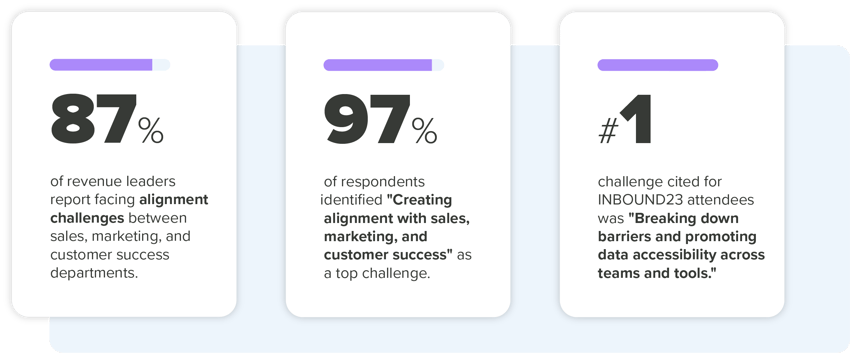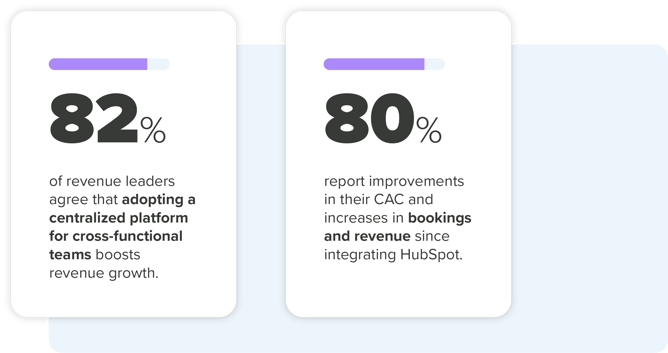Marketing and Sales Leaders Reveal Core Reasons for Misalignment
As we navigate the changing tides, collaboration between marketing, sales, and customer success teams has become absolutely vital. However, 87% of organizations face alignment issues among these core departments. To uncover the root causes, we surveyed over 1,000 revenue leaders spanning Marketing, Sales, and RevOps departments for the State of HubSpot report. Their insights not only reveal the challenges but also hint at potential solutions toward aligning teams around revenue goals and reaching them more efficiently.
What are the Barriers to Sales and Marketing Alignment?
The alignment between marketing and sales is crucial for business growth, but many organizations face challenges in achieving it. Here, we explore the primary obstacles revenue leaders face in bridging the gap between these departments.

"Creating alignment" is the #1 challenge cited at INBOUND.
Finding alignment among teams is not just about working together; it's about moving in the same direction with a shared vision. According to the data, many teams are striving for this, but it is proving to be a challenging path. The State of HubSpot Report revealed that one-third of respondents identified "Creating alignment with sales, marketing, and customer success" as a top challenge. This highlights the critical need for a unified strategy and emphasizes the importance of finding a way to align these departments effectively.
Both Marketing and Sales struggle with data silos.
The value of data cannot be overstated. However, when data is confined within isolated systems, it loses its potential to facilitate collaboration and informed decision-making. The feedback we received from the INBOUND event reinforced the urgency of dismantling these data silos: "Breaking down barriers and promoting data accessibility across teams and tools" emerged as the number-one challenge from our booth attendees.
Teams are seeking mutual understanding and appreciation.
Mutual respect and understanding are the foundation for successful collaboration. However, the data reveals a significant gap in this crucial area, emphasizing the importance of empathy and open dialogue between teams. Both the marketing and sales/revenue departments we surveyed share a mutual feeling that the other lacks insight into their unique challenges and KPIs.
Strategic planning silos are a major barrier to alignment.
Creating a successful strategy is like charting a roadmap to success. However, when departments go their separate ways in isolation, it can result in diverging paths instead of a unified journey forward. Both departments feel that the other is not sufficiently involved in strategic planning, potentially leading to misalignment in goals and execution.
What Challenges Does Marketing Face with Sales Teams?
Marketing, with its focus on brand building and lead generation, often finds itself at a crossroads with the sales department. Let's explore the specific challenges marketers face when trying to align with their sales counterparts, as revealed in our survey of marketing leaders in the State of HubSpot report:
- Walking in Different Shoes (34.46%): The importance of empathy extends beyond the empathy we show customers to how we interact between departments. For marketing teams, feeling that sales don't "get" their challenges can be a significant roadblock to collaboration.
- Strategic Planning Silos (34.06%): There's a perceived limited involvement of the sales/revenue department in marketing's strategic planning. When marketing feels left out of sales' strategic planning, it can lead to disjointed efforts and missed opportunities.
- KPI Confusion (33.27%): Key Performance Indicators (KPIs) are the compass guiding teams toward their goals. Many marketers feel their KPIs are not understood or appreciated by the sales/revenue department.
- Misalignment of KPIs (32.27%): When two departments have different success metrics, it can be challenging to find common ground. This divergence in KPIs calls for a unified approach to measurement.
What are the Sales Teams' Struggles with Marketing?
Sales, driven by targets and closures, often operate at a different rhythm than marketing. In the same survey, we uncover the unique challenges faced by sales professionals in their quest to align with marketing.
- Seeking Mutual Understanding (35.46%): Just as marketing seeks understanding, so does sales. Feeling that marketing doesn't grasp their unique challenges can create friction.
- Deciphering KPIs (35.26%): Sales teams, driven by numbers, rely heavily on KPIs. A perceived lack of understanding from marketing can lead to misalignment.
- Strategic Exclusion (33.07%): Being left out of strategic discussions in the marketing department can also leave sales teams feeling undervalued and misaligned.
- Data Access Barriers (33.07%): Access to timely and relevant data is crucial. For sales, barriers in accessing marketing data can hinder their efforts and decision-making.
How to Align Sales and Marketing
The challenges faced by marketing and sales departments, as highlighted by our data, underscore the pressing need for a solution. The path to alignment, while multifaceted, can be significantly streamlined by adopting a centralized approach across operations.

What is the impact of sales and marketing alignment?
The evidence is overwhelming: 97% of leaders are convinced that achieving better alignment can yield tangible results, such as:
- Increased Revenue (61%): When marketing and sales move in tandem, the result is a streamlined funnel that drives conversions and boosts the bottom line.
- Enhanced Customer Satisfaction (54%): Aligned teams ensure a consistent and cohesive customer journey, leading to satisfied and loyal customers.
- Higher Customer Retention (53%): With both teams working towards a unified goal, customers experience a seamless transition from marketing touchpoints to sales interactions, increasing the likelihood of retention.
Centralized tools provide the cornerstone of collaboration
The world of operations is filled with a multitude of tools and platforms, each claiming to improve a particular aspect of operations. However, the abundance of these tools can often result in confusion rather than clarity. So, what's the remedy? Centralization.
- Unified Workspaces: By adopting centralized tools, teams can collaborate in a unified workspace. This ensures that whether it's marketing crafting a campaign or sales strategizing a pitch, everyone is on the same page—literally and figuratively.
- Seamless Data Sharing: One of the most cited challenges is the breakdown of data silos. With a centralized tool, data can flow seamlessly between departments. Marketing can have real-time insights into sales conversions, and sales can access crucial marketing analytics, ensuring informed decision-making.
- Aligning Around KPIs: A centralized platform allows for the creation of shared KPIs. When both marketing and sales are measuring success using the same yardstick, it fosters a sense of collective responsibility and purpose.
- Goal Setting and Tracking: With a unified tool, setting, tracking, and achieving goals becomes a collaborative effort. Teams can set mutual milestones, track progress, and celebrate collective victories.
HubSpot proven effective for aligning teams and driving revenue.
Centralized tools like HubSpot offer a comprehensive solution to the alignment challenge. With its suite of features tailored for both marketing and sales, it provides a common ground for collaboration. Furthermore, 82% of leaders agree that adopting a centralized platform boosts revenue growth. By placing interoperability and scalability at its core, HubSpot ensures that organizations can align all revenue-driving activities seamlessly.
And the results for HubSpot implementation are in: 80% of respondents reported a decrease in Customer Acquisition Cost (CAC) and an increase in bookings and revenue. This testament to HubSpot's efficacy showcases that when teams are aligned with the right tools, they can achieve direct revenue outcomes.
The Takeaway
Although the journey to achieving marketing and sales alignment may present its fair share of challenges, it holds immense value. By implementing strategies such as centralizing operations, promoting transparent communication, and establishing shared goals, all within a centralized platform, revenue leaders have the power to unlock extraordinary synergy among their teams around sustainable growth.
Download the State of HubSpot Report for a deeper dive into these challenges, solutions, and insights from industry leaders.
Patrick Biddiscombe
Patrick Biddiscombe is the CEO of New Breed. He also spearheads our Revenue department and his background and skills in sales and inbound strategy has contributed immensely to the success of New Breed and our customers' growth.




